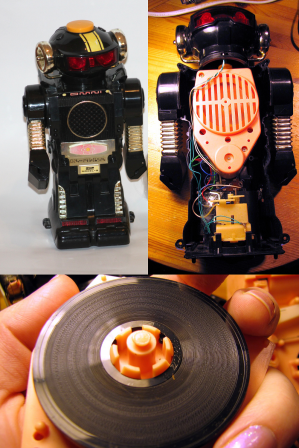
If you were a child of the 80’s or early 90’s you probably remember Magic Mike. He went by many names, but he always said the same thing “I am the atomic powered robot. Please give my best wishes to everybody!” [Oona’s] version of Mike had been malfunctioning for a few years. He’d stopped talking! She decided he needed more input, so she disassembled Mike to reveal the flesh colored plastic box in the center of his chest. This talkbox was used as a sound module in several toys. Before the days of cheap digital playback devices, sounds were recorded in a decidedly analog fashion. [Oona] found that Mike’s voice and sound effects were recorded on a tiny phonograph record in his chest. The phonograph was spun up by an electric motor, but the playback and amplification system was all mechanical, consisting of a needle coupled to a small plastic loudspeaker. The system was very similar to the early phonograph designs.
Mike’s record contained two interwoven spiral tracks. Interwoven tracks is a technique that has been used before, albeit rarely on commercial albums. One track contained Mike’s voice, the other the sound of his laser gun. The track to be played would be chosen at random depending upon where the needle and record stopped after the previous play. The record completely sidetracked [Oona’s] repair work. She decided to try to read the record optically. She started with a high resolution image (image link) of the record, and wrote some Perl code to interpolate a spiral around the grooves. The result was rather noisy, and contained quite a bit of crosstalk. [Oona] tried again with laser illumination using a Lego train set. Unfortunately the Lego train / laser system wasn’t smooth enough to get a good image. In the end she used a bit of Gimp magic and was able to pull better audio from her original image. We never did find out if she put poor Mike back together though.
Continue reading “Atomic Powered Robots And Records Played With Optics”

 Like a lot of parents, [justbennett]’s kids like to play rocket and spaceship command. His kids’ imagination-assigned controls kept shifting from this LEGO to that banana to the dog’s tail, so [justbennett] did what he had to do: make
Like a lot of parents, [justbennett]’s kids like to play rocket and spaceship command. His kids’ imagination-assigned controls kept shifting from this LEGO to that banana to the dog’s tail, so [justbennett] did what he had to do: make 













